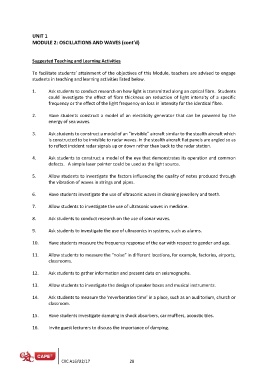Page 528 - SUBSEC October 2017_Neat
P. 528
UNIT 1
MODULE 2: OSCILLATIONS AND WAVES (cont’d)
Suggested Teaching and Learning Activities
To facilitate students’ attainment of the objectives of this Module, teachers are advised to engage
students in teaching and learning activities listed below.
1. Ask students to conduct research on how light is transmitted along an optical fibre. Students
could investigate the effect of fibre thickness on reduction of light intensity of a specific
frequency or the effect of the light frequency on loss in intensity for the identical fibre.
2. Have students construct a model of an electricity generator that can be powered by the
energy of sea waves.
3. Ask students to construct a model of an “invisible” aircraft similar to the stealth aircraft which
is constructed to be invisible to radar waves. In the stealth aircraft flat panels are angled so as
to reflect incident radar signals up or down rather than back to the radar station.
4. Ask students to construct a model of the eye that demonstrates its operation and common
defects. A simple laser pointer could be used as the light source.
5. Allow students to investigate the factors influencing the quality of notes produced through
the vibration of waves in strings and pipes.
6. Have students investigate the use of ultrasonic waves in cleaning jewellery and teeth.
7. Allow students to investigate the use of ultrasonic waves in medicine.
8. Ask students to conduct research on the use of sonar waves.
9. Ask students to investigate the use of ultrasonics in systems, such as alarms.
10. Have students measure the frequency response of the ear with respect to gender and age.
11. Allow students to measure the “noise” in different locations, for example, factories, airports,
classrooms.
12. Ask students to gather information and present data on seismographs.
13. Allow students to investigate the design of speaker boxes and musical instruments.
14. Ask students to measure the ‘reverberation time’ in a place, such as an auditorium, church or
classroom.
15. Have students investigate damping in shock absorbers, car mufflers, acoustic tiles.
16. Invite guest lecturers to discuss the importance of damping.
CXC A16/U2/17 28

